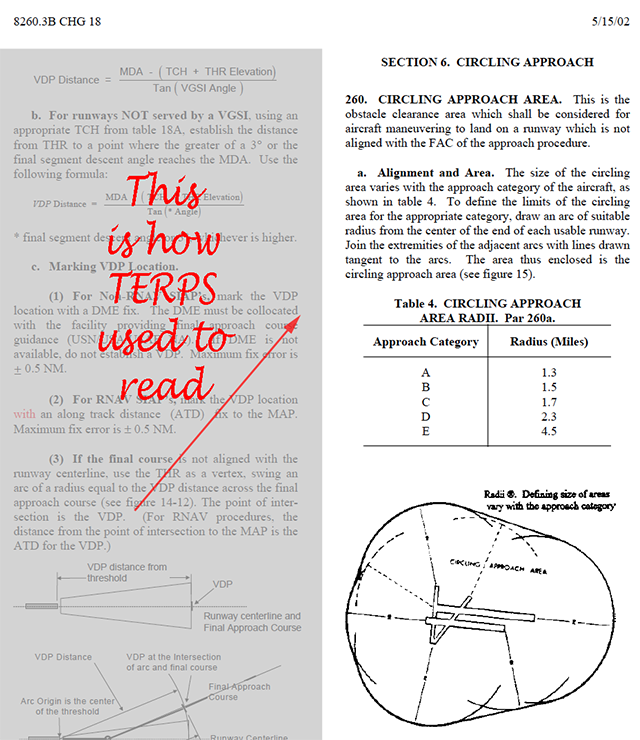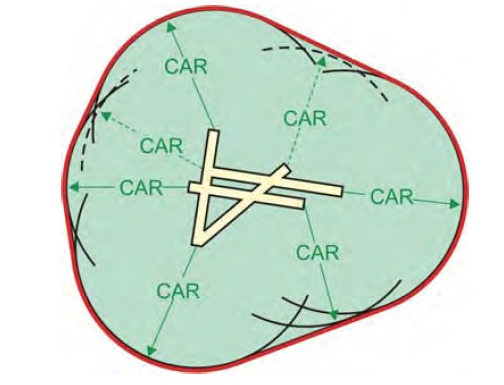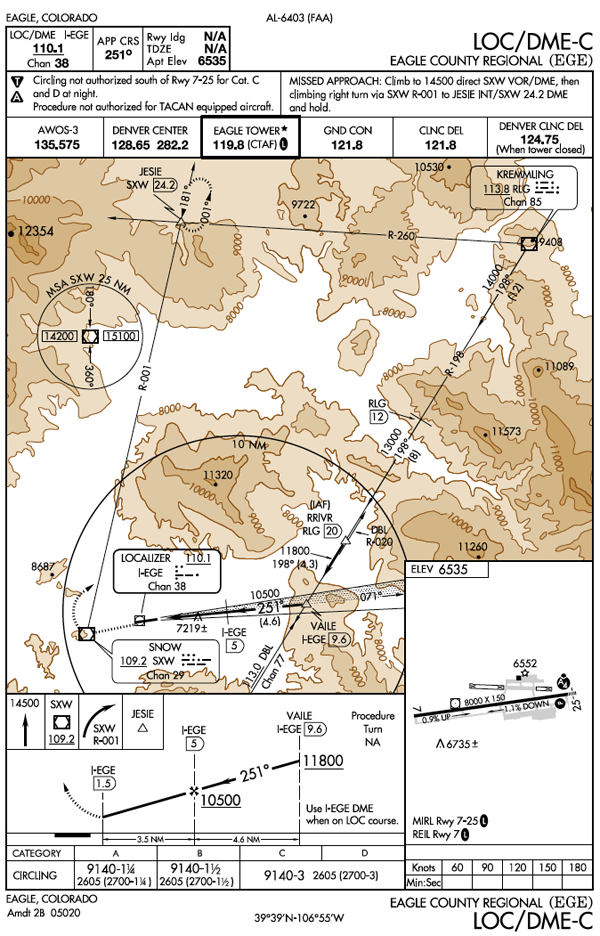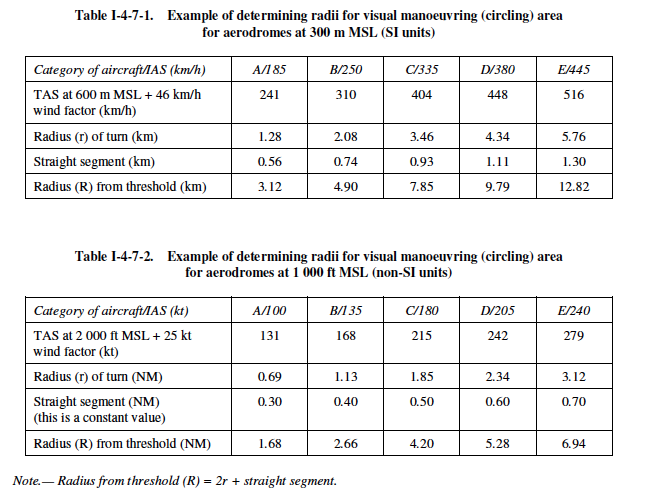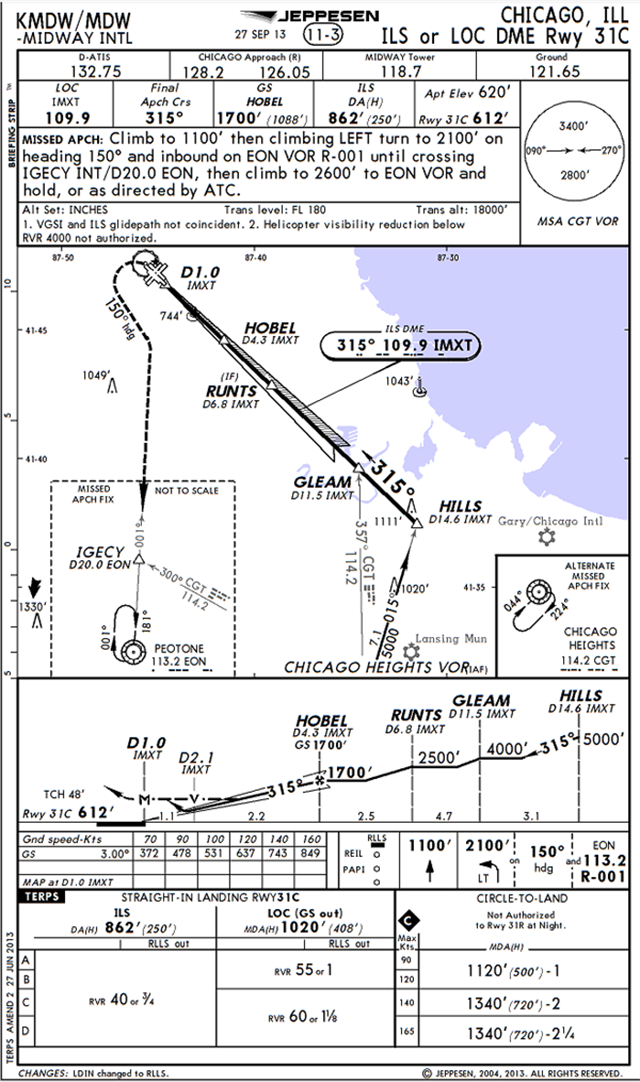A circling approach is designed to keep you above all obstacles within a specified area, the circling approach area. The distance is based on your approach category true airspeed, altitude, bank angle, and the intent of the approach designers. Intent? Yes, the actual circling approach area varies from ICAO to the U.S., and even in the U.S. it varies depending on the rules used.
— James Albright

Updated:
2021-05-03
Fear not, if you keep a few rules of thumb in mind, you will always know when to start your maneuvering and how tight you have to keep those turns.
1 — TERPS - prior to June 5, 2009
2 — TERPS - Change 21 (June 5, 2009)

1
TERPS - prior to June 5, 2009
This looks familiar to most U.S. pilots because it has been the mainstay of circling approach methodology almost from day one. There are many problems with the simple chart. An aircraft's turn radius depends primarily on its bank angle and TRUE airspeed, but the approach category is based on INDICATED airspeed. The TRUE airspeed changes with pressure altitude. Leaving the airspeed issue aside, the circling approach airspace designed under TERPS was awfully small.
TERPS is used to design approach procedures in the United States and in various parts of the world where the U.S. has a presence or the host country simply figured we knew what we are doing and decided to copy us. On April 15, 2002 an Air China Boeing 767 flew into the terrain while flying a TERPS-designed circling at Busan, Korea. (See Air China 129.) While the approach was not listed as causal, the report did suggest that these tight tolerances did not allow large aircraft time to stabilize their approaches.
The FAA, seven years later, updated TERPS. . .
2
TERPS - Change 21 (June 5, 2009)
CIRCLING APPROACH AREA. Where circling is authorized, evaluate the circling approach area for each CAT published on the procedure. The Circling Minimum Descent Altitude (CMDA) is based on the results of the circling area evaluation and the evaluation of the final segment delivering the aircraft to the circling area.
Obstacle Evaluation Area (OEA). The area for each CAT is based on true airspeed (VKTAS). The minimum altitude used for true airspeed conversion is 1,000 ft above airport elevation. Use the following formula for converting indicated airspeed (VKIAS) to true airspeed (VKTAS) is:
Calculate the Circling Approach Radius (CAR) based on true airspeed, bank angle, and straight segment length using the following formula (radian calculations):
Where:
VKTAS = true airspeed
bankangle = bank angle (from table 4)
S = straight segment (from table 4)
*Minimum CAR = 1.30 NM
| CAT V | KIAS | Bankangle | Straight Segment Length (S) |
| A | 90 | 25 | 0.4 |
| B | 120 | 25 | 0.4 |
| C | 140 | 20 | 0.5 |
| D | 165 | 20 | 0.6 |
| E | 200 | 22 | 0.7 |
The OEA is constructed by drawing arcs equal to the CAR for each CAT from the RWT coordinates (or displaced threshold coordinates when applicable) of each runway. Not applicable to permanently closed or other runways not authorized for circling. However, when only one end of the runway is not authorized for circling, the OEA is based on the CAR from both sets of RWT coordinates. Join the outermost arcs with tangential lines. The resulting enclosed area is the circling OEA [no secondary area].
Source: TERPS, ¶260
Simple! All you need is a yoke-mounted slide rule and you are all set. Or maybe a few examples:
The obstacle evaluation area for the VOR/DME-A at Teterboro is based on a 1,000' MSL MDA for Category C and D aircraft and comes to 2.8 nm for Category C and 2.9 nm for Category D.
The turn radius of a 50,000 lb. G450 circling at 131 KCAS will be 4,700' under these conditions, well within the OEA.
A CL-604, circling at 150 KIAS, will have a turn radius of 6,000' under these conditions.
The obstacle evaluation area for the LOC/DME-C at Eagle, Colorado is based on a 9,140' MSL MDA for Category C and D aircraft and comes to 3.4 nm for Category C and 3.5 nm for Category D.
The turn radius of a 50,000 lb. G450 circling at 135 KCAS will be 6,500' under these conditions, well within the OEA.
A CL-604, circling at 150 KIAS, will have a turn radius of 8,500' under these conditions.
Both aircraft at both airports are afforded enough protected airspace.
3
ICAO
The visual manoeuvring area for a circling approach is determined by drawing arcs centred on each runway threshold and joining those arcs with tangent lines (see Figure I-4-7-1). The radius of the arcs is related to:
a) aircraft category;
b) speed: speed for each category;
c) wind speed: 46 km/h (25 kt) throughout the turn; and
d) bank angle: 20° average or 3° per second, whichever requires less bank.
Source: ICAO Doc 8168 Vol I PANS OPS, ¶7.3.1
Though the ICAO Documents don't offer as much background information about circling approach radii as does TERPS, it is clear from the examples that the radius from threshold used to construct their circling approach radii are considerably larger.
4
Aeronautical Information Manual
Circling approach protected areas developed prior to late 2012 used fixed radius distances, dependent on aircraft approach category, as shown in the table on page B2 of the U.S. TPP. The approaches using standard circling approach areas can be identified by the absence of the “negative C” symbol on the circling line of minima. Circling approach protected areas developed after late 2012 use the radius distance shown in the table on page B2 of the U.S. TPP, dependent on aircraft approach category, and the altitude of the circling MDA, which accounts for true airspeed increase with altitude. The approaches using expanded circling approach areas can be identified by the presence of the “negative C” symbol on the circling line of minima.
Source: Aeronautical Information Manual, ¶5-4-20.b.a.
AIM now reflects the expanded airspace but notes there are still (mostly) the tighter approaches. Under the new criteria, you basically have around 3 nm under Category C and 4 nm under Category D. Chances are you will be flying an approach designed under the older criteria. But just because you are flying a Category C aircraft doesn't mean you can't fly using Category D minimums and therefore Category D radii and obstacle clearances.
5
The bottom line
Circling is a visual maneuver and you should never attempt a visual maneuver unless you can roll out on final at 600' at 2 nm from the threshold so as to provide a stabilized approach starting at 500'. It will take you an additional 1 nm to make that turn. You cannot do this unless you have at least 3 nm visibility and you certainly cannot do that under Category C minimums designed under the older TERPS criteria. Do you have Stabilized Approach criteria that says you need to be on speed, on course at 1,000 feet if IMC? If so, why are you in the weather at 1,000 feet prior to a circling maneuver? Therefore . . .

You should never circle at the older TERPS Category C minimums and your minimums for circling should be no lower than 1,000' & 3 nm.
References
(Source material)
Aeronautical Information Manual
ICAO Doc 8168 - Aircraft Operations - Vol I - Flight Procedures, Procedures for Air Navigation Services, International Civil Aviation Organization, 2006
United States Standard for Terminal Instrument Procedures (TERPS), Federal Aviation Administration 8260.3B CHG 25, 03/09/2012
United States Standard for Terminal Instrument Procedures (TERPS), Historic, Federal Aviation Administration 8260.3B CHG 19, 05/15/2002
